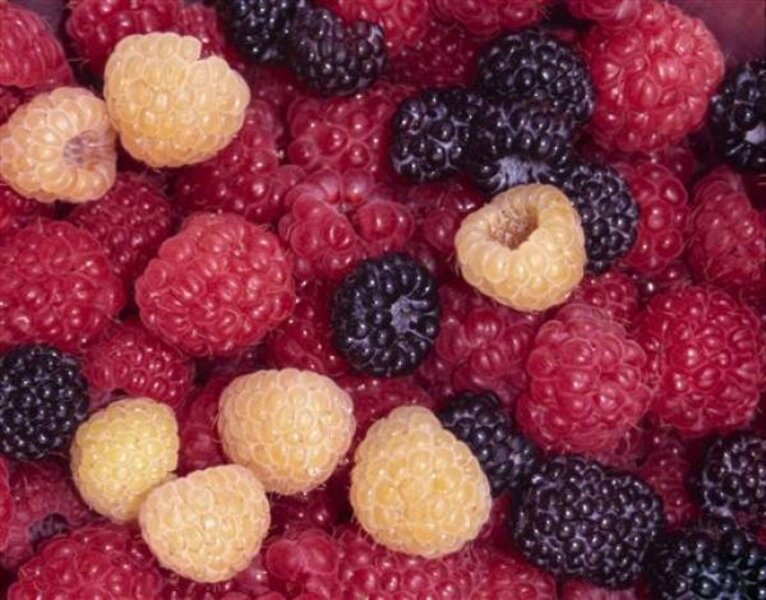Raspberries are easy to grow, delectable, and quick to bear
Loading...
No fruits are tastier or more fragile and perishable than perfectly ripe raspberries. All of which makes a good case for growing them yourself, so they can be picked daily and need travel no more than arm's length.
"Summer bearing" varieties will bear their first berries next summer. But if you plant so-called "everbearing" varieties, you can pick your first berries by the end of this summer.
To get raspberries off to the best possible start, purchase "certified" disease-free plants and give them a well-chosen site. Plants dug from your neighbor's patch may seem economical, but often carry diseases.
The ideal site has well-drained soil in full sun. Avoid disease by not planting where raspberries or other host plants to raspberry diseases — tomato, pepper, eggplant, potato, and strawberry — have recently grown.
Start with the soil
Beef up the fertility and humus content of your prospective raspberry patch. Nitrogen is the nutrient most needed by raspberries, so spread a fertilizer high in nitrogen over the area. Three pounds of soybean meal or two pounds of 10-10-10, for example, can give the needed 0.2 pounds of nitrogen per 100 square feet.
Top this fertilizer with lime if your soil is very acidic, or sulfur if your soil is very alkaline; raspberries enjoy a soil that is just slightly acidic. Provide humus with materials such as compost, leaves, or rotted sawdust.
Mix those materials into the top foot of soil with a rototiller, spade, or garden fork. Turning over the soil also kills perennial weeds, which would be hard to eradicate once your raspberry bed is established.
If weed problems are particularly bad, or if you are starting in established sod, turn the soil over again in two weeks to thoroughly kill existing vegetation.
Plant support
Consider erecting a trellis for your raspberries. Upright plants stay drier — and are thus less prone to disease — and the fruits are within easy reach.
No trellis is necessary for black raspberries trained low, or for an upright-growing everbearer, such as "Heritage," mown to the ground every autumn to bear only a single crop each year.
For the simplest trellis, just string 2 wires between posts. For end posts, use 4-by-4s made from cedar or other rot-resistant wood and sunk into the ground at least 2 feet deep. Brace the endposts to keep them upright, and add middle posts if the row spans more than 30 feet.
Use 12- or 14-gauge wire, one wire 5 feet above the ground and the other 2 feet above the ground. Attach a piece of chain to the ends of each wire to make it easier to loosen them each winter and then tighten them each spring as they expand and contract. Run each chain through a hole you drill in the end post, and hold it in place at the desired tension with a large nail.
And now, the plants
Finally comes the easiest part: the actual planting. First inspect your new raspberries' roots. Shorten lanky ones to 18 inches, and cut back any that are damaged. Then soak the roots for a couple of hours in a bucket of water.
If you must delay planting, store your raspberries in the refrigerator, with their roots wrapped in plastic, or temporarily plant them on the cool, north side of your house or garage.
Out in the garden, dig holes 2 to 3 feet apart along the row. Set each plant in its hole, spread out the roots, and backfill with loose soil. Adjust the planting depth so the crown of each plant is just below ground level.
After planting, cut back all canes to ground level. Those canes made useful planting "handles," but are no longer needed and may harbor cane diseases or sap your new plants' energy by bearing a few fruits. Cutting back these canes also forces development of new canes, which are what you want.
As a final measure, slowly pour a gallon of water around the base of each plant to settle the soil and get your raspberry patch off to a good start. Stand back and imagine the delectable berries on which you'll soon be feasting for years to come.
-----
To read more about gardening, see the Monitor's main gardening page and our lively gardening blog, Diggin' It. Both of these have changed URLs, so we hope you'll bookmark them and return. Want to be notified when there's something new in our gardening section? Sign up for our RSS feed.





